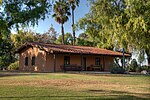Brethren Christian Junior/Senior High School
1947 establishments in CaliforniaAC with 0 elementsChristian schools in CaliforniaHigh schools in Orange County, CaliforniaHuntington Beach, California ... and 2 more
Preparatory schools in CaliforniaPrivate high schools in California
Brethren Christian was a private Christian middle school and high school located in Huntington Beach, California. It was situated on a 15-acre (61,000 m2) site leased from the Huntington Beach City School District, formerly the site of Gisler Middle School. The school was independently operated and controlled by a board of directors. Due to financial troubles, the school eventually dropped its middle school and relocated to the campus of Grace Lutheran Church. The school permanently closed in 2020 following a large deficit and a 64% drop in enrollment.
Excerpt from the Wikipedia article Brethren Christian Junior/Senior High School (License: CC BY-SA 3.0, Authors).Brethren Christian Junior/Senior High School
Strathmoor Lane, Huntington Beach
Geographical coordinates (GPS) Address Nearby Places Show on map
Geographical coordinates (GPS)
| Latitude | Longitude |
|---|---|
| N 33.655337 ° | E -117.958462 ° |
Address
Strathmoor Lane 21141
92646 Huntington Beach
California, United States
Open on Google Maps



